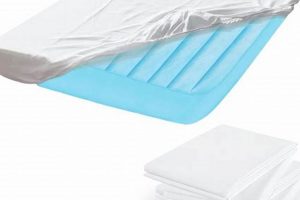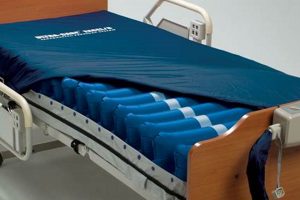A specialized support surface utilizes interconnected air chambers to redistribute pressure. These chambers are alternately inflated and deflated by a pump, thereby minimizing constant pressure on any single area of the body. This system is often employed to prevent or treat pressure ulcers, particularly in individuals with limited mobility.
The significance of such a system lies in its capacity to enhance blood circulation and reduce the risk of tissue damage caused by prolonged pressure. Historically, these surfaces represent an advancement over static support systems, offering a dynamic approach to pressure management. Their use contributes to improved patient comfort and reduced healthcare costs associated with treating pressure-related injuries.
The subsequent sections will delve into the operational mechanics, various types available, selection criteria, and maintenance procedures associated with these medical devices, providing a thorough understanding of their application in different healthcare settings.
Guidelines for Effective Utilization
This section presents practical recommendations for optimizing the effectiveness and longevity of the support surface, ensuring patient comfort and minimizing complications.
Tip 1: Verify Proper Inflation: Ensure the system is fully inflated to the manufacturer’s recommended pressure level before patient placement. Insufficient inflation compromises pressure redistribution capabilities.
Tip 2: Confirm Hose Connections: Regularly inspect all hose connections to the pump and the support surface itself. Loose or disconnected hoses will disrupt the alternating pressure cycle and diminish efficacy.
Tip 3: Adhere to Weight Limits: Always observe the specified weight capacity. Exceeding the weight limit can damage the system and negate its therapeutic benefits.
Tip 4: Implement Routine Cleaning: Establish a protocol for routine cleaning using appropriate disinfectants. This helps prevent the spread of infection and maintains the integrity of the surface material.
Tip 5: Monitor Skin Integrity: Conduct frequent skin assessments, particularly over bony prominences. While the surface aids in pressure redistribution, consistent monitoring is crucial for identifying potential pressure points.
Tip 6: Address Moisture Management: Implement strategies for managing moisture. Excessive moisture can compromise skin integrity and reduce the effectiveness of the surface.
Tip 7: Utilize Appropriate Bedding: Employ moisture-wicking sheets designed for use with these surfaces. Avoid thick, layered bedding, which can interfere with pressure redistribution.
Tip 8: Ensure Proper Pump Placement: Position the pump on a flat, stable surface, ensuring adequate ventilation. Avoid placing the pump directly on the floor or covering it, as this can lead to overheating and malfunction.
Adherence to these guidelines promotes optimal functionality and extends the lifespan of the device, contributing to improved patient outcomes and reduced healthcare costs.
The following sections will provide a deeper understanding of troubleshooting common issues and navigating the purchase process.
1. Pressure Redistribution
The functionality of an air pressure mattress is fundamentally linked to the principle of pressure redistribution. The very design of such a mattress is predicated on its ability to alleviate concentrated pressure on specific areas of a patient’s body. The alternating inflation and deflation of individual air cells, characteristic of this mattress type, creates a dynamic surface that prevents prolonged, uninterrupted compression of tissues against underlying bony prominences. This dynamic action is crucial in preventing the formation of pressure ulcers, also known as bedsores. For example, in patients who are immobilized due to spinal cord injuries or prolonged illness, the use of an air pressure mattress can significantly reduce the risk of developing these debilitating wounds.
The effectiveness of pressure redistribution is directly proportional to the mattress’s ability to conform to the patient’s body contours and to modulate pressure across the support surface. Variations in cell size, inflation cycles, and overall mattress design influence the degree to which pressure is effectively redistributed. Moreover, the type of patient, their weight, body shape, and specific medical conditions necessitate customized settings on the pump to achieve optimal pressure relief. In acute care settings, nurses frequently adjust mattress settings based on a patient’s skin assessment and individual risk factors for pressure ulcer development. Failure to achieve effective pressure redistribution can lead to localized ischemia, tissue hypoxia, and ultimately, tissue necrosis.
In summary, pressure redistribution constitutes the core therapeutic mechanism of an air pressure mattress. The capacity of the mattress to cyclically alter pressure points across the patient’s body directly influences its efficacy in preventing pressure ulcers. Understanding the relationship between mattress design, patient characteristics, and pressure redistribution dynamics is essential for healthcare providers to optimize patient outcomes. The limitations and challenges in achieving optimal pressure redistribution necessitate ongoing research and technological advancements in mattress design and clinical application to further enhance the prevention and management of pressure ulcers.
2. Alternating Inflation
Alternating inflation is a defining operational characteristic of a specific type of support surface. Within these surfaces, independent air cells or chambers undergo cyclical inflation and deflation. This dynamic process distinguishes these systems from static pressure redistribution devices. The purpose is to relieve sustained pressure on any single anatomical area for extended periods. A clinical example is the management of a patient with a spinal cord injury requiring prolonged bed rest; the alternating inflation system mitigates the risk of pressure ulcer formation by continually changing the points of contact between the patient’s skin and the support surface.
The significance of alternating inflation resides in its ability to promote blood circulation to tissues that would otherwise be subjected to constant compression. This improved perfusion helps to prevent ischemia and subsequent tissue necrosis. The inflation cycles are controlled by a pump unit, and the duration and pressure levels of these cycles can be adjusted based on individual patient needs and risk assessments. Modern iterations of these systems incorporate features such as sensors to detect patient movement and adjust inflation cycles accordingly, further optimizing pressure relief. The absence of alternating inflation in a support surface renders i
t less effective in preventing pressure injuries, particularly in high-risk individuals.
In conclusion, alternating inflation is an integral component of these surfaces, driving its primary therapeutic benefit of pressure redistribution. Its absence negates the dynamic pressure relief mechanism, undermining the intended function. The proper functioning of the pump and the careful calibration of inflation cycles are crucial for realizing the full clinical potential of the device. Further research into adaptive algorithms for inflation control promises to enhance the effectiveness and personalization of pressure ulcer prevention strategies.
3. Support Surface
A ‘support surface’ in healthcare encompasses a range of specialized beds, mattresses, and overlays designed to manage pressure, shear, and moisture at the patient-skin interface. The selection of an appropriate support surface is a critical element in preventing and treating pressure ulcers, particularly in individuals with limited mobility or compromised skin integrity. An air pressure mattress represents a specific type of advanced support surface.
- Pressure Redistribution Capabilities
Air pressure mattresses are engineered to dynamically redistribute pressure. They achieve this through interconnected air cells that inflate and deflate in alternating cycles. This constant shifting of pressure points prevents prolonged ischemia and potential tissue damage. In contrast to static support surfaces, which offer consistent support without pressure modulation, air pressure mattresses provide active pressure relief. An example includes a patient recovering from surgery, confined to a bed for extended periods; an air pressure mattress would mitigate the risk of pressure ulcer development by cyclically altering pressure across the patient’s body.
- Moisture Management
Certain air pressure mattress designs incorporate features to manage moisture at the skin surface. Excessive moisture can contribute to skin maceration, increasing the risk of pressure ulcers. Some models integrate low-air-loss technology, where small amounts of air are circulated to wick away moisture. This is particularly beneficial for patients with incontinence or excessive perspiration. The proper maintenance of skin integrity through moisture control is directly linked to the overall effectiveness of the support surface.
- Interface Pressure Monitoring
Advanced air pressure mattress systems may incorporate sensors to monitor interface pressure. These sensors provide real-time data on the pressure exerted between the patient and the support surface. This data allows healthcare providers to optimize mattress settings and ensure adequate pressure relief. The ability to quantify and monitor interface pressure represents a significant advancement in pressure ulcer prevention. An example would be in the ICU setting, where continuous monitoring can alert staff to potential pressure points, enabling timely intervention.
- Microclimate Control
Microclimate control refers to the management of temperature and humidity at the skin-surface interface. Some air pressure mattresses incorporate features to regulate temperature and humidity, creating a more comfortable environment for the patient. This is particularly relevant for patients with fever or those at risk of overheating. By maintaining a stable microclimate, these support surfaces contribute to overall skin health and reduce the risk of pressure ulcer development. In elderly patients, who often have impaired thermoregulation, microclimate control can significantly enhance comfort and well-being.
The multifaceted approach to pressure management offered by air pressure mattresses underscores their importance as a specialized form of support surface. Their ability to dynamically redistribute pressure, manage moisture, monitor interface pressure, and control the microclimate positions them as valuable tools in preventing and treating pressure ulcers across diverse patient populations. The selection of an appropriate air pressure mattress should be based on a comprehensive assessment of the patient’s individual risk factors and needs.
4. Patient Comfort
The relationship between patient comfort and an air pressure mattress is paramount in the context of long-term care and recovery. The primary goal of such a mattress is to alleviate pressure points and redistribute weight, minimizing the risk of pressure ulcers. However, the effectiveness of this pressure redistribution directly influences patient comfort. A properly functioning and appropriately adjusted air pressure mattress can significantly reduce pain and discomfort associated with prolonged bed rest or immobility. Conversely, an improperly inflated or malfunctioning mattress can exacerbate discomfort, negating its therapeutic benefits. The sensation of being adequately supported and free from localized pressure is a critical component of patient-reported outcomes, impacting satisfaction and overall well-being.
Several factors contribute to the comfort level provided by an air pressure mattress. The material composition of the mattress surface, the adjustability of pressure settings, and the integration of features such as low-air-loss technology all play a role. For example, a mattress with a breathable cover can improve air circulation and reduce skin maceration, leading to enhanced comfort. Similarly, the ability to customize pressure settings based on individual patient weight and body composition ensures optimal support and minimizes the risk of both pressure ulcers and discomfort. In clinical practice, patient feedback should be routinely solicited to ensure that the mattress settings are appropriately calibrated and that any discomfort or pressure points are promptly addressed. A failure to prioritize patient comfort can lead to non-compliance with prescribed bed rest, potentially hindering recovery and increasing the risk of complications.
In conclusion, patient comfort is not merely a secondary consideration but an integral aspect of the therapeutic efficacy of an air pressure mattress. The mattress’s ability to provide effective pressure redistribution, combined with features designed to enhance breathability and adjustability, directly impacts patient well-being. Regular monitoring of patient comfort levels and proactive adjustments to mattress settings are essential to optimize outcomes and ensure patient compliance. The ongoing development of air pressure mattress technology should prioritize both clinical effectiveness and patient-centered design to further enhance comfort and promote healing.
5. Skin Integrity
The maintenance of skin integrity is inextricably linked to the application of an air pressure mattress. Skin, the body’s primary protective barrier, is susceptible to breakdown when subjected to prolonged pressure, shear forces, and moisture. The primary function of an air pressure mattress is to mitigate these factors, thereby preserving skin integrity, particularly in individuals with limited mobility or compromised health. For instance, a post-operative patient confined to bed for an extended period is at high risk for developing pressure ulcers due to su
stained pressure on bony prominences. An air pressure mattress, by cyclically alternating pressure distribution, prevents prolonged compression of tissues, promoting blood flow and reducing the risk of skin breakdown. Therefore, maintaining skin integrity becomes a central performance component of an air pressure mattress.
The effectiveness of an air pressure mattress in preserving skin integrity is contingent upon several factors, including proper inflation levels, appropriate pressure settings tailored to the patient’s weight and body composition, and the absence of wrinkles or foreign objects between the mattress and the patient’s skin. Furthermore, regular skin assessments are crucial to identify early signs of pressure damage, such as redness or blanching. In cases where incontinence is a factor, the use of moisture-wicking pads in conjunction with an air pressure mattress can further protect skin integrity. Clinical observations consistently demonstrate that the consistent and correct application of an air pressure mattress significantly reduces the incidence of pressure ulcers compared to standard mattresses in at-risk populations.
In summary, the correlation between skin integrity and air pressure mattresses is one of direct cause and effect. The mattress is designed to prevent pressure-induced skin damage, and its effectiveness in doing so directly impacts the preservation of skin integrity. Challenges remain in ensuring consistent and correct usage across diverse healthcare settings, as well as in optimizing mattress design to address individual patient needs. Ongoing research and clinical practice refinement are essential to maximizing the benefits of air pressure mattresses in maintaining and protecting skin integrity.
6. Prevent Ulcers
The primary clinical justification for the utilization of an air pressure mattress is the prevention of pressure ulcers, also known as bedsores or decubitus ulcers. These ulcers develop when sustained pressure on the skin restricts blood flow to the underlying tissues, leading to ischemia, tissue damage, and ultimately, necrosis. Individuals with limited mobility, such as those who are bedridden, paralyzed, or recovering from surgery, are particularly vulnerable. An air pressure mattress is specifically designed to mitigate this risk by cyclically redistributing pressure across the patient’s body, preventing prolonged compression of any single area. This dynamic pressure relief promotes blood circulation and reduces the likelihood of tissue breakdown. For example, a patient immobilized after a stroke may benefit significantly from the use of such a mattress, as the cyclical pressure changes minimize the risk of pressure ulcer formation on bony prominences such as the sacrum and heels.
The effectiveness of an air pressure mattress in preventing ulcers hinges on several factors, including proper mattress selection, appropriate pressure settings, and diligent patient monitoring. Different mattress designs offer varying degrees of pressure redistribution, and the optimal choice depends on the patient’s individual risk factors and clinical condition. Furthermore, the pressure settings must be adjusted according to the patient’s weight and body mass index to ensure adequate pressure relief without compromising comfort. Regular skin assessments are crucial for identifying early signs of pressure damage, such as redness or blanching, which may necessitate adjustments to the mattress settings or the implementation of additional preventive measures. For instance, in a nursing home setting, routine skin checks combined with the use of air pressure mattresses can significantly reduce the incidence of pressure ulcers among elderly residents.
In conclusion, the prevention of pressure ulcers is the central rationale for employing air pressure mattresses. These mattresses function by dynamically redistributing pressure, thereby mitigating the risk of tissue ischemia and subsequent ulcer formation. While the effectiveness of these mattresses is well-documented, proper selection, appropriate settings, and vigilant monitoring are essential to maximize their clinical benefits and minimize the risk of complications. Future advancements in mattress technology and clinical practice should focus on optimizing pressure redistribution strategies and enhancing patient comfort to further reduce the burden of pressure ulcers in vulnerable populations.
Frequently Asked Questions
The following section addresses common inquiries regarding the nature, application, and maintenance of specialized pressure redistribution surfaces.
Question 1: What is the primary function of an air pressure mattress?
The primary function is to redistribute pressure away from bony prominences. The mattress aims to prevent prolonged pressure concentration on any single area of the body, thereby mitigating the risk of pressure ulcer formation.
Question 2: How does an air pressure mattress operate?
These mattresses utilize a system of interconnected air cells that inflate and deflate in an alternating pattern. A pump controls the cycle, creating a dynamic surface that prevents continuous pressure on tissues.
Question 3: What are the key benefits associated with air pressure mattress usage?
The key benefits include reduced risk of pressure ulcers, improved blood circulation, enhanced patient comfort, and potential for accelerated healing of existing pressure injuries.
Question 4: What are the essential maintenance procedures for an air pressure mattress?
Essential maintenance includes regular cleaning with approved disinfectants, inspection of air hoses for leaks or disconnections, adherence to weight limits, and verification of proper inflation levels.
Question 5: Are all air pressure mattresses suitable for all patients?
No. Mattress selection should be based on individual patient factors, including weight, skin condition, mobility level, and specific risk factors for pressure ulcer development. Consultation with a healthcare professional is recommended.
Question 6: What are the potential risks or complications associated with air pressure mattress use?
Potential risks include skin maceration due to excessive moisture, discomfort if pressure settings are not properly adjusted, and potential for equipment malfunction if maintenance procedures are not followed. Regular monitoring and adherence to manufacturer guidelines are crucial.
This information provides a foundational understanding of air pressure mattresses. Understanding proper usage is essential for maximizing therapeutic benefits and minimizing potential complications.
The subsequent section will delve into the economic considerations and cost-effectiveness analysis associated with implementing this type of pressure redistribution support surface.
Conclusion
The preceding exploration of the air pressure mattress has illuminated its multifaceted role in modern healthcare, particularly in the prevention and management of pressure ulcers. Through dynamic pressure redistribution, these surfaces offer a significant advantage over static alternatives, promoting improved blood circulation and minimizing the risk of tissue damage. The correct application of these mattresses, predicated on careful patient assessment, appropriate settings, and diligent monitoring, is crucial for realizing their full therapeutic potential.
As healthcare systems continue to prioritize patient safety and cost-effectiveness, the judicious implementation of air pressure mattresses remains a critical strategy. Ongoin
g research and technological advancements hold promise for further refinement of these surfaces, optimizing their functionality and enhancing patient outcomes. The commitment to evidence-based practice and continuous quality improvement is essential to ensuring the widespread and effective utilization of this valuable tool in the fight against pressure ulcers.







